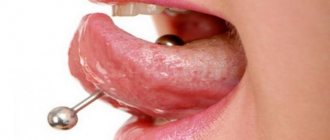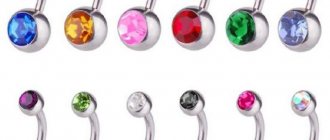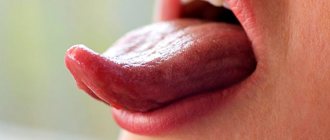Causes of infection after tongue piercing
From a medical point of view, piercing is a procedure associated with violating the integrity of the skin (invasive). And, like many other similar procedures, it can cause a variety of consequences. The following problems are typical for oral piercings:
- allergy to the material from which the jewelry is made, or to the drug that was used to treat the puncture site;
- formation of scars;
- chronic injury to teeth and mucous membranes;
- increased salivation (hypersalivation);
- development of infection and, as a consequence, inflammation [1].
Infection of a puncture site in the oral cavity occurs mainly for two reasons:
- After the procedure, the wound is not cared for or care is carried out incorrectly or irregularly.
- The biological balance in the oral cavity is disrupted due to the constant locally irritating effect of decoration.
In the oral cavity, a microbiome is formed and exists in a more or less constant quantitative and qualitative composition. This is a collection of microorganisms that normally (when there are no inflammations or other provoking factors) are in biological balance. This means that opportunistic microorganisms are not activated and do not lead to infection, because there are no prerequisites for this [2].
Only with the advent of molecular genetic research methods did the study of the biology of microorganisms (microbiome) truly begin as one of the leading triggers for the development and progression of inflammatory diseases of the dental system.
They inhabit the mucous membranes, the back of the tongue, the gingival sulcus, oral fluid and dental plaque, receiving the necessary proteins, carbohydrates, amino acids, inorganic and other substances from the oral fluid. Occupying only 0.03–0.05 m² of oral cavity area, the microbiome of this ecological niche includes representatives from 530 to 700 stable species. Katola V.M., Ph.D., leading researcher at the Institute of Geology and Environmental Management, Far Eastern Branch of the Russian Academy of Sciences [2]
Some microorganisms play a positive role in the health of the oral cavity, mucous membranes, and teeth. Thus, bifidobacteria, in the course of their life activity, help to increase local immunity in the mouth, suppress the development of pathogenic flora, and reduce the likelihood of developing caries. At the same time, streptococci, actinomycetes and other microorganisms increase the level of acids, which over time dissolve tooth enamel, which increases the sensitivity of teeth, decreases their mineral density (primarily due to the destruction of calcium and fluoride), and inflammation of periodontal tissues develops. which hold the tooth in the socket [2].
Tongue piercing as an injury and jewelry that is inserted into the hole changes the biochemical balance of the environment inside the oral cavity. The protective properties of saliva, the rate of its secretion and the activity of enzymes change, the hygienic condition of the oral cavity and teeth deteriorates, the mechanism of chewing and articulation changes. All this, in combination with other factors, leads to the creation of conditions under which “bad” bacteria, that is, opportunistic bacteria, multiply more actively. Microbes easily settle on the inflamed tissue at the puncture site, multiply and cause an infectious process. Most often, after tongue piercing, infection is associated with various pathogens: Actinomyces, Campylobacter, Neisseria, Streptococcus, Candida fungi and others [3, 4]
Pros and cons of piercings
One of the advantages of piercing is the ability to stand out, be stylish and special. The decoration is easily hidden and does not immediately catch the eye. In addition, it is possible to get rid of several kilograms, since the diet during the rehabilitation period is strictly limited.
The “disadvantages” of the procedure include the following:
- long wound healing, painful sensations;
- high probability of wound infection if the operation was performed independently or with non-sterile instruments;
- problems with gums and teeth due to inappropriate oral care.
It is worth considering that the development of such negative consequences as changes in taste sensitivity, severe bleeding, the appearance of speech defects, damage to tooth enamel, and numbness of the tongue is possible.
Tongue piercing is contraindicated for pregnant women due to the high risk of infection, for people with diabetes, and for people under 18 years of age.
Read also: Product quality indicators
The procedure is dangerous if you are allergic to anesthetics or the material of the bar, or if you have an elevated temperature. Prohibited for neurological disorders and chronic pathologies.
Typical symptoms after piercing
Of course, not every piercing leads to infection, but some vigilance is needed. A tongue piercing is an injury, and it heals in the same stages as other injuries. This stage lasts, according to various sources, up to 10–14 days. Typical complaints and symptoms after piercing are:
- swelling;
- pain or discomfort in the puncture area;
- feeling of tightness, numbness of the tongue;
- tingling, burning, especially when food, drinks, or medications come into contact with the wound;
- discharge of a small amount of blood or yellowish serous fluid [1, 4].
Installed jewelry can be a factor of permanent trauma, and this leads to chronic low-grade inflammation, in which there is minor local swelling and slight redness due to disruption of the integrity of the epithelium.
Original and provocative tongue piercing: pros and cons, how it will be
Photo from the site:
Read also: What is Samsung Pass on a phone?
It is worth understanding what it is to decorate your own body, it is far from easy, and you will have to make this decision if you really want to have such an original accessory in your mouth as a stud bar. Moreover, few people realize that tongue piercing, the consequences of which may not be pleasant, to put it mildly, also has a secret sacred meaning. The first such punctures were invented by the ancient tribes of American Indians, who, with its help, performed special rituals to reunite their divine nature with their human nature.
Need to know The tongue piercing operation is practically painless and is most often performed without the use of anesthesia or any anesthetics. However, the healing process can be quite painful. For example, you will have to switch to liquid food for a while, give up a lot of things that you are used to, so you should think carefully about everything in advance before agreeing to the procedure.
However, the secret meaning of this action has been completely lost over the centuries, and modern fashionistas and fashionistas are already doing tongue piercing for completely different reasons. Each person may have their own reasons, but the most common is, of course, giving special pleasure to a partner in terms of sex, and this is an important factor that, of course, must be taken into account.
Possible signs of infection
If an infection is added to post-traumatic inflammation, local and general symptoms of infection occur. Their appearance is associated with a protective reaction at the local and general level of the body in response to chronic inflammation and changes in the microbial composition in the oral cavity. Accordingly, there are differences between local (in the oral cavity and on nearby tissues) and general manifestations of the infectious-inflammatory process associated with a cascade of reactions to the pathological process. These symptoms can appear at any time.
Local symptoms include:
- increased pain;
- the appearance of a twitching pain that can spread (give) to the ear, nose, submandibular area, and head;
- the tongue “tastes” hot, a change in its relief occurs;
- increased swelling;
- in the mirror you can see redness, sometimes whitish films, veins of blood vessels;
- the appearance of cloudy discharge, possibly with an unpleasant taste and odor [4].
General symptoms:
- increased body temperature;
- chills;
- body aches;
- decreased appetite;
- increased fatigue;
- enlargement of local lymph nodes (on the neck, on the back of the head, behind the ears) [4].
Why do girls get their tongues pierced?
There is no clear answer to this question. There are several reasons and aspects that encourage young people to turn to the services of piercers. So, why do you need to decorate your tongue?
It is beautiful
Many people believe that piercing is a pretty spectacular way to decorate themselves. Those who like a decoration on their tongue in the form of a small bead or crystal are ready to make small sacrifices: endure pain, carry out regular sanitation of the oral cavity, and remove unpleasant plaque. You can decorate both the tip of the tongue and its middle using various types of accessories: rings, labrets, dumbbells, nails that may contain precious stones. But most often simple jewelry made of medical steel, Teflon, titanium and other materials that are most compatible with the human body are used.
It's fashionable
Many people, especially when they are young, blindly follow fashion. In a company—at school, university, or simply among peers—it is customary to use various ways to emphasize one’s belonging to a particular social group. And many people, often girls, not wanting to be left behind, pierce this part of the body. Less often, a puncture is performed to resemble one’s idol - a star in the world of music or cinema.
It's bold
At a young age, it is common to experiment with your appearance. For many people, the search for themselves leads through various types of decoration of their body, including through tattoos and piercings. If parents and other elders fail to dissuade a guy or girl from getting a piercing, then the decoration in the mouth becomes a legacy of stormy youth and the search for one’s own style.
Those who like to provoke others, attract attention to themselves, deliberately causing both positive and negative emotions in other people, use body modifications for this purpose. There is even a whole movement of so-called. freaks who use various methods of changing their body in order to shock others with an unusual and even repulsive appearance.
It's sexy
Many people love it when girls have decorations on their tongues. The emphasis on the mouth is a direct hint at intimate relationships. It is believed that if a woman emphasizes or decorates her mouth in any way, this means that she is sexually liberated. Some girls get piercings for a specific purpose - to enhance sensations during kissing and oral sex, giving more pleasure to their partner.
It's nice
It may seem strange to many, but some people derive pleasure from experiencing pain. Puncture of different parts of the body, which have many nerve endings, causes a rush of adrenaline and strong emotions in people. Pronounced pain sensations allow you to achieve catharsis. For the same reasons, psychologists explain, some people cover their bodies with tattoos and perform other types of pain-related modifications.
It's entertaining
Other people pierce their tongues, as they say, for fun. They may like the feeling of a foreign body in their mouth. Sometimes you can hear that piercing in some way enhances the sense of taste due to additional stimulation of nerve endings and papillae. There are also those who simply enjoy feeling a small ball and playing with it in their mouth.
How to prevent infection
There are many reasons for the development of infection after piercing, and they are not always associated with non-compliance with aseptic and antiseptic methods during puncture. But given the invasiveness of the procedure, you need to carefully choose a salon for piercing, focusing on the recommendations of Rospotrebnadzor. The main points of infection prevention are simple [5]:
- Do not carry out procedures during acute illness (colds, indigestion, herpes rashes, etc.) or during exacerbation of chronic diseases.
- Perform piercing only in a certified center, where the sterility of the instruments and the puncture process is maintained.
- Follow the recommendations for caring for the postoperative wound.
- Take regular and proper oral care [1, 4].
Preparation for the procedure
To avoid the development of complications, it is important to know several points before starting the procedure:
- Select the first earring wisely: the alloy of the product should not oxidize. The first bar should be larger in size than the permanent one - this is due to the fact that after the puncture the tongue swells. When the canal heals and the swelling subsides, the temporary product is replaced with a smaller piece of jewelry. There should be no samples, engravings, or various patterns on the surface. If the bar is not smooth, the puncture channel takes longer to heal, as it is injured by the patterns. In this case, the healing period can be several months.
- Tongue treatment: during the operation, the specialist himself disinfects the puncture site. After the procedure, you will need a care product and rinse to rinse your mouth, which will be recommended by a specialist.
- Selecting a clinic and specialist: the main thing is health and safety, so it’s worth finding an experienced and trusted piercer. The place where the procedure is performed must be clean. A prerequisite for the operation of such establishments is the presence of a sterilization zone where disinfection equipment is located (trays, boxes, dry-heat ovens).
Non-dental infections after piercing
Like any injury, piercing reduces the body's defenses. At this time, dormant infections outside the oral cavity may become active and cause an acute process. If hygienic requirements, asepsis and antiseptics are not observed during piercing, there is a risk of contracting infections transmitted by “blood”, blood transfusion, when poorly treated instruments or hands, on which particles of infected blood of a sick visitor to the piercing salon remain, the infection enters the blood of a healthy one. This is how HIV, tetanus, and hepatitis are transmitted [1].
How is tongue piercing done?
Tongue barbell piercing (it is better to choose a product based on individual characteristics and preferences), despite the established opinion, is still considered a surgical intervention. The operation should be carried out exclusively in a professional and qualified salon.
Step-by-step algorithm for tongue piercing:
- Fixation of the position of the tongue using a special clamp, which is characterized by the presence of a hole for a future puncture.
- Piercing the tongue using a special needle in a clamp. Since it is important that the needle is as sterile as possible, it is better to use disposable instruments. This will reduce the chance of infection.
- Inserting the rod into the resulting hole using a tool.
- Removing the clamp and needle.
Since the procedure does not require much time, it can be performed without the use of an anesthetic . If the patient has a low pain threshold or is afraid of blood, painkillers may be used.
After the procedure, the person must rinse the mouth using a special disinfection solution. The most commonly used substance is “Chlorhexidine”, which is diluted with water in a ratio of 1:4.
To ensure that the puncture is even, the master can use special markings. It is important that the future piercing site is located strictly in the center of the tongue. Placing the jewelry close to the root causes severe chafing and discomfort.
Non-infectious problems after piercing
Reactions to piercings are unpredictable and varied, but it is impossible to predict whether a particular patient will have them or not and what they will be. You should remember the risk of problems that are not related to the infectious-inflammatory process, but that affect the functioning of the dentofacial apparatus and the patient’s dental health. Piercing can provoke allergic reactions, periodontopathies, defects in hard dental tissues, tongue abscess, hypersalivation, impaired diction, galvanism, and scar formation [4].
Pros of tongue piercing
If you like to have your mouth literally looked into, a tongue piercing is the way to go. In any case, people will want to look at the earring; they will be interested in whether it hurts, how much it costs, why they decided to do it, and so on.
You will attract attention without even telling or showing your piercing - people will already pay attention to it when you talk or laugh - it is impossible not to notice the sparkling “something” in your mouth. This will make people listen to you and look at you willy-nilly.
KK Adapt. 5 paragraph
The piercing can be removed from your tongue at any time, and no one will guess that you had it. For example, during a business meeting or meeting the parents of the bride/groom.
Treatment of an infected tongue
If you experience complaints similar to an infection, you should consult a doctor to diagnose the causes and determine treatment tactics. It consists of removing decorative piercings (sometimes replacing them with silicone ones), antiseptic treatment, and prescribing local and systemic antibiotics. If necessary, the wound is drained, sometimes surgical excision is performed, followed by closure of the defect. It must be remembered that chronic trauma to the tongue due to piercing can lead to malignancy—cancerous degeneration [4].











